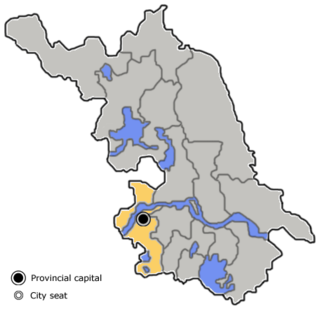This biography of a living person needs additional citations for verification .(June 2014) (Learn how and when to remove this template message) |
| Gang Tian | |
|---|---|
 Gang Tian at Oberwolfach in 2005 | |
| Born | 24 November 1958 Nanjing, Jiangsu, China |
| Nationality | China |
| Alma mater | Harvard University Peking University Nanjing University |
| Known for | Bogomolov–Tian–Todorov theorem |
| Awards | Veblen Prize (1996) Alan T. Waterman Award (1994) |
| Scientific career | |
| Fields | Mathematics |
| Institutions | Princeton University Peking University |
| Doctoral advisor | Shing-Tung Yau |
| Doctoral students | Nataša Šešum |
Tian Gang (simplified Chinese :田刚; traditional Chinese :田剛; pinyin :Tián Gāng; born November 1958) [1] is a Chinese mathematician and an academician of the American Academy of Arts and Sciences. He is known for his contributions to geometric analysis and quantum cohomology especially Gromov-Witten invariants, among other fields.

Simplified Chinese characters are standardized Chinese characters prescribed in the Table of General Standard Chinese Characters for use in mainland China. Along with traditional Chinese characters, they are one of the two standard character sets of the contemporary Chinese written language. The government of the People's Republic of China in mainland China has promoted them for use in printing since the 1950s and 1960s to encourage literacy. They are officially used in the People's Republic of China and Singapore.

Traditional Chinese characters are Chinese characters in any character set that does not contain newly created characters or character substitutions performed after 1946. They are most commonly the characters in the standardized character sets of Taiwan, of Hong Kong and Macau, and in the Kangxi Dictionary. The modern shapes of traditional Chinese characters first appeared with the emergence of the clerical script during the Han Dynasty, and have been more or less stable since the 5th century.
Hanyu Pinyin, often abbreviated to pinyin, is the official romanization system for Standard Chinese in mainland China and to some extent in Taiwan. It is often used to teach Standard Mandarin Chinese, which is normally written using Chinese characters. The system includes four diacritics denoting tones. Pinyin without tone marks is used to spell Chinese names and words in languages written with the Latin alphabet, and also in certain computer input methods to enter Chinese characters.
Contents
- Biography
- Mathematical contributions
- Editorial Positions
- Selected publications
- References
- External links
He was born in Nanjing, and was a professor of mathematics at the Massachusetts Institute of Technology from 1995–2006 (holding the chair of Simons Professor of Mathematics from 1996), but now divides his time between Princeton University and Peking University. His employment at Princeton started from 2003, and now his title there is Higgins Professor of Mathematics; starting 2005, he has been the director of the Beijing International Center for Mathematical Research (BICMR); [2] he has also been Dean of School of Mathematical Sciences, Peking University since 2013. [3] He and John Milnor are Senior Scholars of the Clay Mathematics Institute (CMI). In 2011, Tian became director of the Sino-French Research Program in Mathematics at the Centre national de la recherche scientifique (CNRS) in Paris. In 2010, he became scientific consultant for the International Center for Theoretical Physics in Trieste, Italy. [4]

Nanjing, formerly romanized as Nanking and Nankin, is the capital of Jiangsu province of the People's Republic of China and the second largest city in the East China region, with an administrative area of 6,600 km2 (2,500 sq mi) and a total population of 8,270,500 as of 2016. The inner area of Nanjing enclosed by the city wall is Nanjing City (南京城), with an area of 55 km2 (21 sq mi), while the Nanjing Metropolitan Region includes surrounding cities and areas, covering over 60,000 km2 (23,000 sq mi), with a population of over 30 million.

The Massachusetts Institute of Technology (MIT) is a private research university in Cambridge, Massachusetts. Founded in 1861 in response to the increasing industrialization of the United States, MIT adopted a European polytechnic university model and stressed laboratory instruction in applied science and engineering. The Institute is a land-grant, sea-grant, and space-grant university, with a campus that extends more than a mile alongside the Charles River. Its influence in the physical sciences, engineering, and architecture, and more recently in biology, economics, linguistics, management, and social science and art, has made it one of the most prestigious universities in the world. MIT is often ranked among the world's top universities.

Princeton University is a private Ivy League research university in Princeton, New Jersey. Founded in 1746 in Elizabeth as the College of New Jersey, Princeton is the fourth-oldest institution of higher education in the United States and one of the nine colonial colleges chartered before the American Revolution. The institution moved to Newark in 1747, then to the current site nine years later, and renamed itself Princeton University in 1896.












